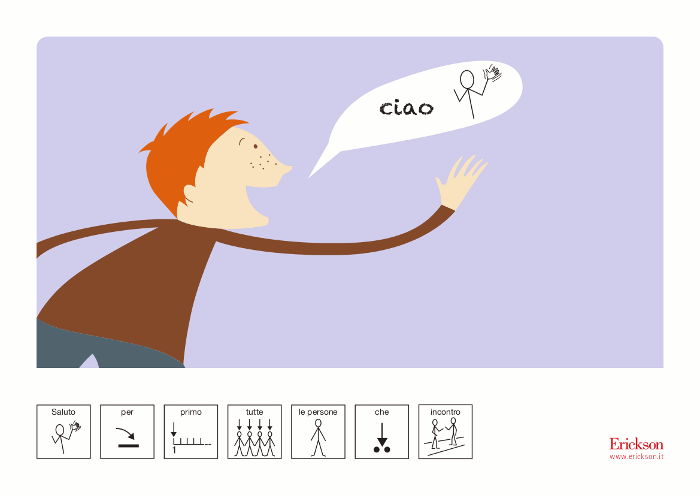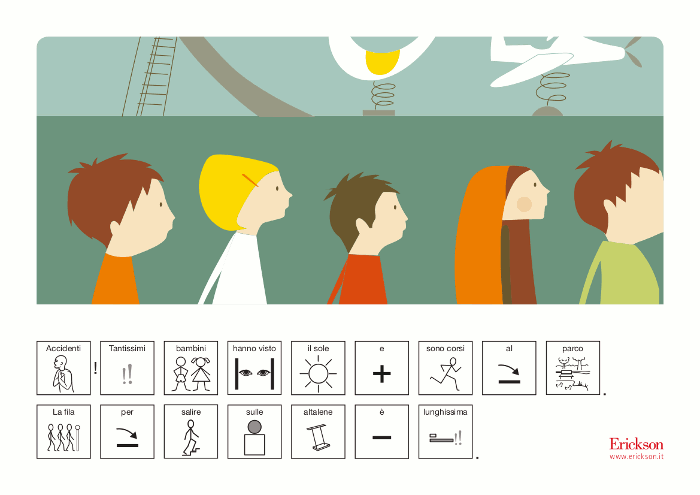 EN
EN
 PT
PT
IN-books for inclusion and early intervention
Product: Book
Trim size in cm: 17x24
Pages: 260
ISBN: 9788861377769
Publication date: 01/03/2012
REQUEST A SAMPLE OR MORE INFORMATION
Research on cognitive, linguistic and emotional development has shown that learning through listening is very important for young children. In particular, children with learning and communication disabilities profit enormously from this experience. Unfortunately, they are those who are the least exposed to it, also because it is difficult to find suitable books.
This book has grown out of experience with children, families, schools and social workers in the field of Augmentative and Alternative Communication (AAC); it introduces IN-books—illustrated books drawn from children’s literature, printed with symbols that are personalized for each child. IN-books are a wonderful resource for the support and inclusion of special education students.
The volume opens with an introduction on the importance of narrative in human history, on the specificity of cooperative communication, on complex communication needs, and on the nature of AAC. Then the structure and the use of IN-books is explored: the book and subject choice, the reference models and the possible adaptations (text and sentence structure, symbols, illustrations, formats etc.)
- Presentation (Joanne Cafiero) - Introduction - Adults reading illustrated books – Narrating and communicating – Children with complex communication needs – The history of “personalized” books – Inclusion tools – The content – The text in symbols - Illustrations – The layout, the format and adaptations - Instructions - Conclusions - Acknowledgements - Bibliography - Sitography - Appendix - Coauthors

What are in-books?
They are illustrated books with text written entirely in symbols, designed to be listened to whilst another person reads out loud.
How did they come about?
They came about from an Italian experience of Augmentative and Alternative Communication (AAC), with the help of parents, teachers and operators, and they started appearing spontaneously and rather unexpectedly in houses, nursery schools, libraries and many other places. They have since become an important resource for all children, not only those with a communication disability.
How do you read in-books

The most specific element in reading books with symbols out loud is the use of modelling. The person reading constantly moves their finger over the symbols one by one as they read, trying not to let this movement interfere with the liveliness of the story telling. Your finger should be placed beneath the symbol so that both the symbol and the written word, which is placed above so that your finger does not cover it, can be clearly seen. Sometimes, during reading, you can point out details in the picture as well as the symbol, in order to emphasise key moments in the story. It is generally an adult who reads and points at the symbols, whilst the child or children listen.
What do the symbols mean?

Sometimes children want to point to the symbols whilst the adult reads and they enjoy controlling the adult's reading. Some children need to hold the adult's hand during modelling and to feel the movement and rhythm of the reading. The opposite, however, is not recommended - in other words the adult taking the child's hand and moving it passively. Children are never asked to look or point themselves: they are simply «exposed» to the continued pointing, one symbol at a time, in a playful manner. Pointing provides considerable support in capturing the attention of another person and creating shared attention in an environment of common reference. The continued movement of pointing from one symbol to the next accompanies the child's gaze symbol by symbol and facilitates sequence building.
Both transitions are particularly important for children who have difficulties, above all those with praxic and gaze tracking difficulties, like in children with autism spectrum disorders. With the latter, you may initially get the impression that they are not looking or following. If the book is motivating and attracts their attention, you just need to be patient and wait.
The advantages of modelling

In general, children quickly learn how modelling works, they only need to see an adult pointing at the symbols a couple of times before they start doing the same, automatically and naturally imitating what they have seen being done. They thus start to use modelling spontaneously to read IN-books, to themselves or out loud to other children. Through progressive modelling, and without the need for explanations and reminders, they automatically learn the correspondence between the word heard, the symbol and the written word. Reading books with symbols from this viewpoint becomes one of their first «grown-up» activities and children can start to do it on their own, without the constant mediation of an adult. The structure of IN-books enables children to «read» the symbols on their own. Although in the beginning they tend to enjoy the reading out loud and modelling done by an adult they soon learn to appreciate the possibility of enjoying the book on their own. It is not rare to see children who, despite not having developed the function of alphabetic reading, read to each other out loud, pointing at and recognising one by one the symbols in the text, thus supporting their future development of alphabetic reading and writing.
To find out more about AAC and in-books